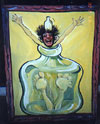Office
of Moribund Collections
This series of brief reports looks at art galleries and museums or art
museums housing dubious collections of objects and art works. The research
project will also bring public attention to some of the world's most horrendous
and inappropriate public "art". Initially the reports will cover Australia
and New Zealand where thriving tourist industries have nurtured the growth
of "secondary attractions" some of which are arguably more interesting
than "primary attractions". The 'secondary' or 'b-grade' attraction is
noted for its lack of professionalism, sloppy display, pathos, the poor
condition of its objects, the insignificance of its objects and of course,
the misguided enthusiasm of its "curators". The role played by institutions
such as these is to assure us of what is not art and introduce the tourist
to a plethora of priceless objects of little or (in a best case scenario)
no value.
The Outdoor Sculpture Park, near
Kaikoura, New Zealand
This is the ultimate in democratic public art. Environmental artworks
are created by the public in an expanse of rocks fronting a particularly
rough patch of ocean. Although it is sometimes difficult to distinguish
between art and nature, it is clear that many of the art works are such
that they could not have been created by natural forces alone. Here a
pile of rocks or a swastika imitate high art while flirting courageously
with the infinite and the immeasurable. Like Caspar David Friedrich these
artists have discovered "tragedy in the landscape".
Office
of Public Erections
The
Statue of Donald Duck, foreshore, Picton, Queen Charlotte Sound, New Zealand
A lost-structural review of Picton's decaying statue of Donald Duck which
exemplifies man's struggle against nature. A struggle that this sculpture
would have you believe that man has lost. The spectacular scenery upon
which the duck has turned its back highlights an enduring fear of that
which cannot be tamed. To fully understand this extraordinary work we
must view the protagonist within the context of a duck who has turned
its back on the water and thus nature itself. A duck with human pretensions,
created by humans for humans. A duck stripped of its "duckness". This
astonishing statue is also an excellent example of enduring post colonial
insensitivity to the land and its original inhabitants. WARNING: Each
article will be illustrated with images that may cause convulsions in
discerning readers...
Hell's Gate/Tikitere, Rotorua, Aotearoa/New Zealand
The publicity brochure describes Hell's Gate/Tikitere
as "the beast !" "...You walk past steaming fumeroles and pools of boiling
mud so violent they are unnerving ... you will see unearthly vistas."
You certainly will. The most unearthly vista, however, is not geothermal.
It is what appears to be the face of a Maori warrior that one encounters
on the walk to the active volcanic crater. This was once an area where
warriors returning from battle bathed to salve their wounds and today
tourists and locals continue to take the curative waters for a fairly
substantial fee...
Office
of Cataclysmic Tourism, Marketing Division
The Department of Cataclysmic Tourism will provide up to date accounts
of tourist attractions based on disasters of catastrophic proportions.
The spectre of death hovers over these attractions and importantly, they
would not be attractions without considerable loss of life. This section
deals with a type of nostalgia for times that no one in their right mind
would want to relive. And yet there are popular virtual experiences which
enable the tourist to participate vicariously in the horrors of both natural
and man made catastrophes.
*
Napier, New Zealand
Following a devastating earthquake in 1931 the city of Napier was rebuilt.
What the earthquake didn't destroy, fire took care of. For 60 years the
Napier stagnated and by the 1990s the rebuilt city was largely intact.
It appears that also around this time the locals woke from a deep sleep
and it occurred to them that they lived in an almost entirely art deco
environment. Thus began the preservation of a strange, beautiful and isolated
treasure. Napier is exemplary of a city where the remembrance of things
past is closely tied to an apocalyptic event in which many lives were
lost, structures and infrastructures destroyed, the harbour vanished,
the city raised and chaos ensued. Today tourists can experience the intensity
of the earthquake in the museum's earthquake room and hear accounts from
the people who were (really) there. One can then wander through the deco
wonderland immersing oneself in a potent atmosphere of cataclysmic nostalgia.

